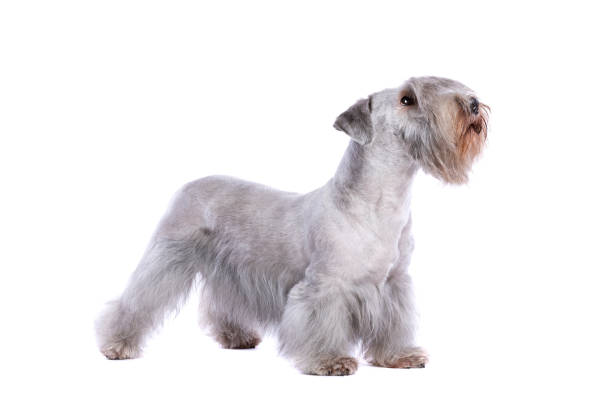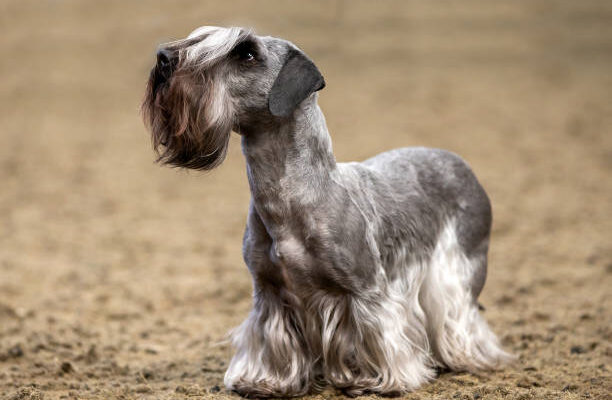The Cesky Terrier brings pleasure to enthusiasts throughout its life through its charming physical structure and soft fur, and kind disposition, which distinguishes it in the terrier family. This handbook provides detailed information about the Cesky Terrier’s complete existence, including its ancestral background alongside physical aspects and training lessons and grooming schedules, and daily household requirements.
Table of Contents
- Introduction to Cesky Terriers
- History and Origin
- Physical Characteristics
- Personality and Temperament
- Training a Cesky Terrier
- Exercise and Activity Needs
- Nutritional Requirements and Diet
- Grooming and Hygiene
- Common Health Issues and Preventive Care
- Socialization and Behavior
- Living Conditions and Adaptability
- Fun Activities and Games
- Conclusion
Introduction to Cesky Terriers
The Cesky Terrier exists as “Bohemian Terrier” yet retains its official name since it emanated from Czechoslovakia’s forest hunting grounds. People love this canine breed because of its elegant appearance and friendly nature, even though it maintains strong terrier characteristics with a mild spirit and family characteristics.
Among the numerous relatives in the terrier category, the Cesky Terrier shines because it combines excellent affection along with intelligence and easy manageability. These dogs represent an appealing breed to dog lovers because their special characteristics, including their smooth coat and short legs, along with their muscular body, create an interesting and charming appeal.
History and Origin

Bred with Purpose
In the 1940s, the Cesky Terrier came into existence through the breeding work of Czech breeder František Horák. The goal of breeder František Horák was to develop a hunting terrier suitable for the dense forests of Bohemia, which would be fast while having a calmer temperament for increased trainability.
Parent Breeds:
- Sealyham Terrier
- Scottish Terrier
By carefully selecting and crossbreeding these two terrier types, Horák succeeded in creating a dog that could track, hunt, and adapt to family life with ease.
Rise to Recognition
Horák achieved successful breeding that eventually caused the Cesky Terrier to become popular throughout Europe during the 1950s. Official recognition of the breed came through the Fédération Cynologique Internationale (FCI) in 1963 before the American Kennel Club (AKC) granted its recognition in 2011.
Fun Fact: The Cesky Terrier stands as a unique member of dog breeds globally, with its devoted enthusiasts making up its mainly limited worldwide following.
Physical Characteristics
Size and Build
- Height: 10–13 inches (at the shoulder)
- Weight: 14–24 pounds
- Build: Low to the ground, muscular yet elegant
Cesky Terriers combine strength and agility in a compact package, showcasing a long head, deep chest, and strong legs suitable for moving through tough terrain.
Coat and Colors
Cesky Terriers exist as reputation-based breeds because of their delicate, silky coat texture and slight wave pattern.
- Coat Texture: Soft and flowy, easy to part down the back
- Color Development: Puppies are born black and lighten to shades of gray-blue or light coffee brown as they mature, typically around 2–3 years.
Recognized Colors:
- Gray-blue (most common)
- Light coffee brown (rare)
Their unique coat requires specific grooming techniques to maintain its beauty, as it doesn’t shed heavily but can mat without regular care.
Personality and Temperament
What Are Cesky Terriers Like?
These dogs carry within them dual characteristics of standard terrier traits, together with relaxed, affectionate qualities. Their behavior embodies energetic vitality in addition to smartness without the challenge of being hardheaded.
Key Traits:
- Loyal and affectionate with family
- Reserved but polite with strangers
- Less aggressive than many terriers
- Strong prey drive (especially toward small animals)
Are Cesky Terriers Good Family Dogs?
Absolutely. When part of a household, Cesky Terriers bond strongly with every member, including their young relatives. Families who want a sturdy, small pet with endless affection should consider the Cesky Terrier because of their quiet, patient nature.
Parents must watch their children around dogs to stop them from causing unintentional harm to the dogs.
Do Cesky Terriers Serve Well as Watchdog Dogs?
Cesky Terriers have no aggression within their nature, although they use their barking to warn household members about unknown individuals near their residence. The watchful nature of their senses enables them to be dependable watchdogs, yet they choose to observe incidents first before making a move.
Training a Cesky Terrier
Intelligence and Trainability
The Cesky Terrier can learn quickly because they have both brains for learning and a commendable drive to obey commands, yet they depend most on positive encouragement combined with training structure.
Basic Training Tips:
Xy Terrier puppies should experience training together with socialization efforts through their first months of life.
The training routine should include a combination of food rewards together with verbal praise, along physical signs of affection.
Brief training periods should be used to stop the dog from getting bored during exercises.
Cesky Terriers need a combination of firm and delicate leadership because they dislike aggressive handling.
Because of their delicate nature, Cesky Terriers need trainers who practice both patience and consistency and deliver encouragement.
Socialization
A Cesky Terrier needs early socialization to form into an assured and balanced dog. A Cesky Terrier without contact with various settings and people and animals tends to develop extreme wariness or severe shyness.
Socialization Ideas:
- Puppy classes
- Visits to parks and pet-friendly stores
- Calm introductions to new animals and humans
A well-socialized Cesky becomes a stable, adaptable adult companion.
Exercise and Activity Needs
Daily Exercise Requirements
Although Cesky Terriers maintain less physical activity than other breeds of terrier, they must get exercise every day.
Minimum Exercise: 45–60 minutes per day
Exercise Ideas:
- Leisurely walks
- Playtime in a fenced yard
- Games of fetch or hide-and-seek
- Agility training sessions
Mental Stimulation
Their brain demands mental puzzles that stimulate their mind.
Mental Engagement Ideas:
- Puzzle toys
- Obedience or trick training
- Nose work games (finding hidden objects)
- Interactive feeding games
Without proper stimulation, Cesky Terriers can become bored and potentially mischievous.
Nutritional Requirements and Diet
Recommended Diet
To support their energetic nature and muscular frame, Cesky Terriers need dietary protein sources together with nutritious fats within a balanced and premium diet.
Ideal Foods:
- Lean meats (chicken, turkey, lamb)
- Salmon and sardines for omega-3s
- Vegetables like spinach, carrots, and pumpkin
- Fruits such as blueberries and apples (in moderation)
Avoid fillers such as corn and soy, and steer clear of foods high in fat, which can lead to weight gain.
Feeding Schedule
- Puppies: 3 small meals daily
- Adults: 2 well-balanced meals per day
Portion control and maintaining a lean physique are crucial for preventing common weight-related health issues.
Always ensure constant access to fresh water and limit high-calorie treats.
Grooming and Hygiene
Grooming Routine
Cesky Terriers need regular grooming sessions because they possess a shiny and hypoallergenic coat.
Grooming Essentials:
- Brushing: 2–3 times per week to prevent mats
- Bathing: Every 6–8 weeks with a gentle dog shampoo
- Professional Trimming: Every 6–8 weeks to maintain the signature Cesky outline
- Nail Trimming: Every 2–3 weeks
- Ear Cleaning: Weekly
- Dental Care: Brush teeth 2–3 times a week
Tip: Many Cesky owners learn to clip their dogs themselves, using specialized grooming guides for this unique breed.
Coat Maintenance by Age
- Puppies: Regular brushing to familiarize them with grooming tools
- Adults: Routine trims and coat conditioning to keep hair healthy and tangle-free
Common Health Issues and Preventive Care
Common Health Conditions
Although generally healthy, Cesky Terriers can be predisposed to certain genetic conditions:
- Scottie Cramp: A neuromuscular disorder causing movement issues under stress
- Progressive Retinal Atrophy (PRA): Leads to vision deterioration
- Hip Dysplasia: Uncommon but possible
- Patellar Luxation: Dislocation of the kneecap
Preventive Care
Health Tips:
- Annual veterinary checkups
- Vaccination maintenance
- Early screening for genetic disorders
- Monitoring joint health
- Regular dental cleanings
Early intervention leads to better health outcomes and longer, happier lives.
Socialization and Behavior
Tips for Socializing Your Cesky Terrier:
Provide your Cesky Terrier with regular play sessions with multiple canine friends.
The dog should meet different individuals, along with objects and environmental noises, in an environment that remains peaceful.
Treats and positive reinforcement should reward your Cesky Terrier when it shows brave behavior while remaining composed.
Natural interaction development should be maintained without coercion to enhance dogs’ curiosity.
Special Note: .Proper socialization of Cesky Terriers remains important because they exhibit territorial behaviors due to insufficient socialization time.
Common Behavioral Traits
- Adaptable: Thrives in varied living situations
- Loyal: Forms intense family bonds
- Sensible: Calm when appropriate, lively during play
- Observant: Always aware of surroundings
- Playful: Loves engaging games with their humans
Living Conditions and Adaptability
Best Living Environments
The Cesky Terrier becomes suited to different residential setups when pet parents provide proper exercise and care.
Ideal Homes:
- Apartments (with daily walks)
- Suburban houses with fenced yards
- Rural properties with supervised outdoor time
Climate Sensitivity
- Cold Weather: Tolerates cooler climates relatively well but benefits from a sweater in freezing conditions.
- Hot Weather: Needs access to shade, cool areas, and fresh water to prevent overheating.
Fun Activities and Games
Physical and Mental Games
Activity Ideas:
- Short agility courses
- Games of fetch and tug-of-war
- Hide-and-seek with toys or treats
- Scent work games to satisfy their hunting instincts
Enrichment Tools
- Treat-dispensing toys
- Training clickers and reward systems
- Interactive puzzle boards
- DIY obstacle courses
Keeping the Cesky Terrier mentally and physically active helps maintain their happiness and prevents boredom-based behaviors.
Conclusion
The Cesky Terrier separates itself by bringing together terrier high spirits with soft family pet nature. These dogs work well as pets because of their obedience combined with sharp intelligence and flexible nature, which requires owners to dedicate care and movement exercises.
Key Takeaways:
Cesky Terriers need regular exercise, which should be both physical and mental.
A Cesky Terrier requires necessary grooming of its coat to stay healthy and attractive.
The early socialization process leads dogs to become confident, well-adjusted adult pets.
Due to their loving nature and energetic presence, Cesky Terriers excel as ideal domestic pets for families.
When owners accept a Cesky Terrier into their lives, they start a joyful journey that combines playful discoveries, elegant benefits, and loyal friendship.




